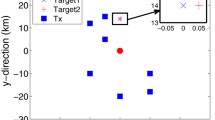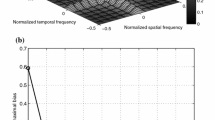Abstract
We present an algorithm to detect the presence of 3D target motion from ISAR data. Based on the 3D point scatterer model, we first examine the effect of 3D motion on ISAR imaging. It is shown that existing motion compensation algorithms cannot properly focus targets exhibiting 3D motion during the imaging interval. An algorithm is then derived to blindly detect the degree of 3D target motion from raw radar data. It is based on measuring the linearity of phases between two or more point scatterers on the target. The phase estimation is implemented using the adaptive joint time-frequency technique. Examples are provided to demonstrate the effectiveness of the 3D motion detection algorithm with both simulation and real ISAR data. The detection results are corroborated with the truth motion data from on-board motion sensors and correlated with the resulting ISAR images.
Similar content being viewed by others
References
C.C. Chen and H.C. Andrews, “Target Motion Induced Radar Imaging,” IEEE Trans. Aerospace Electron. Syst., vol. 16, no. 1, Jan. 1980, pp. 2–14.
A. Ausherman, A. Kozma, J.L. Waker, H.M. Jones, and E.C. Poggio, “Developments in Radar Imaging,” IEEE Trans. Aerospace Electron. Syst., vol. 20, no. 4, July 1984, pp. 363–400.
W.G. Carrara, R.S. Goodman, and R.M. Majewski, Spotlight Synthetic Aperture Radar-Signal Processing and Algorithms, Boston, MA: Artech House, 1995.
S. Werness, W. Carrara, L. Joyce, and D. Franczak, “Moving Target Imaging Algorithms for SAR Data,” IEEE Trans. Aerospace Electron. Syst., vol. 26, no. 1, Jan. 1990, pp. 57–67.
D.E. Wahl, P.H. Eichel, D.C. Ghiglia, and C.V. Jakowatz, “Phase Gradient Autofocus-A Robust Tool for High Resolution SAR Phase Correction,” IEEE Trans. Aerospace Electron. Syst., vol. 30, no. 3, July 1994, pp. 827–835.
Y. Wang, H. Ling, and V.C. Chen, “ISAR Motion Compensation via Adaptive Joint Time-Frequency Techniques,” IEEE Trans. Aerospace Electron. Syst., vol. 34, no. 2, Apr. 1998, pp. 670–677.
Z. Liu, R. Wu, and J. Li, “Complex ISAR Imaging of Maneuvering Targets via the Capon Estimator,” IEEE Trans. Signal Processing, vol. 47, no. 5, May 1999, pp. 1262–1271.
V.C. Chen and W.J. Miceli, “Effect of Roll, Pitch and Yaw Motions on ISAR Imaging,” in SPIE Proc. Radar Processing, Technology and Applications VI, vol. 3810, Denver, CO, July 1999, pp. 149–158.
J. Li, Y. Wang, R. Bhalla, H. Ling, and V.C. Chen, “Comparison of High-Resolution ISAR Imagery from Measured Data and Synthetic Signatures,” SPIE Proc. Radar Processing, Technology and Applications VI, vol. 3810, Denver, CO, July 1999, pp. 170–179.
A.W. Rihaczek and S.J. Hershkowitz, “Choosing Imaging Intervals for Identification of Small Ships,” SPIE Proc. Radar Processing, Technology and Applications VI, vol. 3810, Denver, CO, July 1999, pp. 139–148.
S. Xiao and D.C. Munson, “Spotlight-Mode SAR Imaging of a Three-Dimensional Scene Using Spectral Estimation Techniques,” in Proc. IEEE Inter. Geosci. and Remote Sensing Symp., vol. 2, Seattle, WA, July 1998, pp. 642–644.
J.T. Mayhan, M.L. Burrows, K.M. Cuomo, and J.E. Piou, “High Resolution 3D ‘snapshot’ ISAR Imaging and Feature Extraction,” IEEE Trans. Aerospace Electron. Syst., vol. 37, no. 2, Apr. 2001, pp. 630–641.
M.A. Stuff, “Three-Dimensional Analysis of Moving Target Radar Signals: Methods and Implications for ATR and Feature-Aided Tracking,” SPIE Proc. Algorithms for Synthetic Aperture Radar Imagery VI, vol. 3721, Aug. 1999, pp. 485–496.
H. Ling, Y. Wang, J. Li, and R. Bhalla, “ISAR Image Formation of TIRA Data Using Adaptive Joint Time-Frequency Processing,” in NATAO Sensors and Electronics Technology Symposium on High Resolution Radar Techniques, Granada, Spain, Mar. 1999, pp. 61.1–61.7.
Rights and permissions
About this article
Cite this article
Li, J., Ling, H. & Chen, V. An Algorithm to Detect the Presence of 3D Target Motion from ISAR Data. Multidimensional Systems and Signal Processing 14, 223–240 (2003). https://doi.org/10.1023/A:1022285411791
Issue Date:
DOI: https://doi.org/10.1023/A:1022285411791




